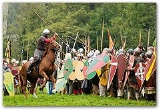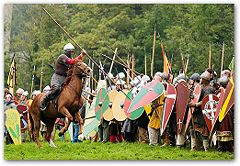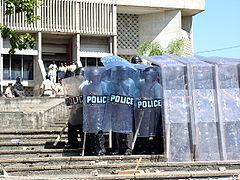
Shield wall
Encyclopedia

Shield
A shield is a type of personal armor, meant to intercept attacks, either by stopping projectiles such as arrows or redirecting a hit from a sword, mace or battle axe to the side of the shield-bearer....
s" formed by soldiers standing in formation
Tactical formation
A tactical formation is the arrangement or deployment of moving military forces such as infantry, cavalry, AFVs, military aircraft, or naval vessels...
shoulder to shoulder, holding their shields so that they abut or overlap. Each man benefits from the protection of his neighbor's shield, usually the man to his right, as well as his own.
Ancient times
This tactic was used by many ancient armies including the Persian SparabaraSparabara
The Sparabara, meaning "shield bearers" in Persian, were the heavy front line infantry of the Achaemenid Persian Empire. They were usually the first to engage in hand to hand combat with the enemy...
, Greek hoplite
Hoplite
A hoplite was a citizen-soldier of the Ancient Greek city-states. Hoplites were primarily armed as spearmen and fought in a phalanx formation. The word "hoplite" derives from "hoplon" , the type of the shield used by the soldiers, although, as a word, "hopla" could also denote weapons held or even...
phalanx formation
Phalanx formation
The phalanx is a rectangular mass military formation, usually composed entirely of heavy infantry armed with spears, pikes, sarissas, or similar weapons...
, and Roman legion
Roman legion
A Roman legion normally indicates the basic ancient Roman army unit recruited specifically from Roman citizens. The organization of legions varied greatly over time but they were typically composed of perhaps 5,000 soldiers, divided into maniples and later into "cohorts"...
s.
The shield wall came into use in ancient Greece during the late eighth or early seventh century BC. The soldiers in these shield wall formations were called hoplites, so named for their heavy weaponry (hopla, "ὅπλα"). These were three-foot shields made from wood and covered in metal. Instead of fighting individual battles in large skirmishes, hoplites fought as cohesive units in this tight formation with their shields pushing forward against the man in front (to use weight of numbers).The left half of the shield was designed to cover the unprotected right side of the hoplite next to them. The worst, or newest, fighters would be placed in the middle front of the formation to provide both physical and psychological security.
Roman legions used a type of shield wall called a testudo formation
Testudo formation
In Ancient Roman warfare, the testudo or tortoise formation was a formation used commonly by the Roman Legions during battles, particularly sieges. Testudo is the Latin word for "tortoise"...
in which the first row formed a dense vertical shield wall and the back rows held shields over their heads, thus forming a tortoise-like defense, impenetrable to missile weapons. The man at the right hand of each warrior had an important role; he covered the right side of the warrior next to him with his shield. This made it so that all the shields overlap each other and thus formed a solid battle line. The second row was to kill the soldiers of the first line of an enemy shield wall, and so trying to break it. All the other rows were weight for the pushing match that always occurs when both sides tried to break the other wall. When a wall was broken the battle turned into a single-combat melee in which the side whose wall collapsed had a serious disadvantage.
In the late Roman army
Late Roman army
The Late Roman army is the term used to denote the military forces of the Roman Empire from the accession of Emperor Diocletian in 284 until the Empire's definitive division into Eastern and Western halves in 395. A few decades afterwards, the Western army disintegrated as the Western empire...
and the Byzantine army
Byzantine army
The Byzantine army was the primary military body of the Byzantine armed forces, serving alongside the Byzantine navy. A direct descendant of the Roman army, the Byzantine army maintained a similar level of discipline, strategic prowess and organization...
, similar formations of locked shields and projecting spears were called fulcum (φοῦλκον, phoulkon in Greek), and were first described in the late 6th-century Strategikon. Roman legions were typically well-trained, and often used short stabbing-swords (such as the Gladius
Gladius
Gladius was the Latin word for sword, and is used to represent the primary sword of Ancient Roman soldiers. Early ancient Roman swords were similar to those used by the Greeks. From the 3rd century BC, the Romans adopted swords similar to those used by the Celtiberians and others during the early...
) in the close-quarters combat that inevitably resulted when their shield-walls contacted the enemy. Auxiliaries were often less armed, therefore to provide more defence a shield-wall with spearmen was commonly used.
Early Medieval Period

Anglo-Saxons
Anglo-Saxon is a term used by historians to designate the Germanic tribes who invaded and settled the south and east of Great Britain beginning in the early 5th century AD, and the period from their creation of the English nation to the Norman conquest. The Anglo-Saxon Era denotes the period of...
and the Danes, most of the Saxon army would have been the poorly trained Fyrd
Leidang
The institution known as leiðangr , leidang , leding, , ledung , expeditio or sometimes lething , was a public levy of free farmers typical for medieval Scandinavians. It was a form of conscription to organise coastal fleets for seasonal excursions and in defence of the realm...
-- a militia composed of farmers and other lower-class folk. However, the shield-wall tactics of the day did not require any great skill, being essentially a shoving match with weapons. A few select warriors, such as Huscarls, carried heavier weapons and consistently wore armour. These men operated primarily as support for the main wall, and as bodyguards for highly placed Thegns and royalty.
The vast majority of opponents in such battles were armed with spears, which they used against the unprotected legs or faces of their opponents. Short weapons, such as the ubiquitous seax
Seax
Seax in Old English means knife or cutting tool. The name of the roofer's tool, the zax, is a development from this word...
, could also be used in the tight quarters of the wall. Limited use of archery
Archery
Archery is the art, practice, or skill of propelling arrows with the use of a bow, from Latin arcus. Archery has historically been used for hunting and combat; in modern times, however, its main use is that of a recreational activity...
and thrown missile weapons occurred in opening stages of shield-wall battles, but were rarely decisive to the outcome. The drawback of the shield-wall tactic was that once breached, the whole affair tended to fall apart rather quickly. Untrained fyrdmen gained morale from being shoulder-to-shoulder with their mates, but typically fled once this was compromised. Once the wall was breached, it could prove difficult or impossible to re-establish a defensive line, and panic might well set in among the defenders.
The tactic was used at the Battle of Stamford Bridge
Battle of Stamford Bridge
The Battle of Stamford Bridge took place at the village of Stamford Bridge, East Riding of Yorkshire in England on 25 September 1066, between an English army under King Harold Godwinson and an invading Norwegian force led by King Harald Hardrada of Norway and the English king's brother Tostig...
, where the relatively well-armed Saxon army hit a Viking
Viking
The term Viking is customarily used to refer to the Norse explorers, warriors, merchants, and pirates who raided, traded, explored and settled in wide areas of Europe, Asia and the North Atlantic islands from the late 8th to the mid-11th century.These Norsemen used their famed longships to...
army unawares. The Vikings were not wearing any armour, and after a bloody shield-wall vs. shield-wall battle, fled in panic. There were few survivors on the Viking side, while the English took moderate casualties. Both sides at the Battle of Hastings
Battle of Hastings
The Battle of Hastings occurred on 14 October 1066 during the Norman conquest of England, between the Norman-French army of Duke William II of Normandy and the English army under King Harold II...
are clearly visible in the Bayeux Tapestry
Bayeux Tapestry
The Bayeux Tapestry is an embroidered cloth—not an actual tapestry—nearly long, which depicts the events leading up to the Norman conquest of England concerning William, Duke of Normandy and Harold, Earl of Wessex, later King of England, and culminating in the Battle of Hastings...
using the tactic, though Norman
Normans
The Normans were the people who gave their name to Normandy, a region in northern France. They were descended from Norse Viking conquerors of the territory and the native population of Frankish and Gallo-Roman stock...
mounted cavalry ultimately won the day -- portending the end of massed shields in combat. When two forces formed shield walls they would often be at a standstill for hours. The process of creating a shield wall was to interlock shields in a wall like formation this in turn made it almost impossible to break the line. The formation used to break shield walls was known as the boar snout.
Decline
The shield-wall as a tactic has declined and has been resurrected a number of times. For example, in the Greek and Macedonian phalanxes, as the DoryDory (spear)
The dory or doru - ie not pronounced like the fish - is a spear that was the chief armament of hoplites in Ancient Greece. The word "dory" is first attested in Homer with the meanings of "wood" and "spear". Homeric heroes hold two dorys...
spear gave way to the sarissa
Sarissa
The sarissa or sarisa was a 4 to 7 meter long spear used in the ancient Greek and Hellenistic warfare. It was introduced by Philip II of Macedon and was used in the traditional Greek phalanx formation as a replacement for the earlier dory, which was considerably shorter. The phalanxes of Philip...
, it became impossible to carry a large shield and so it was abandoned.
Likewise, in the Late Middle Ages, the shield was abandoned in favour of polearms carried with both hands, giving rise to the pike square
Pike square
The pike square was a military tactic developed by the Swiss Confederacy during the 15th century for use by its infantry.- History :The pike square was used to devastating effect at the Battle of Nancy against Charles the Bold of Burgundy in 1477, when the Swiss defeated a smaller but more...
tactics.
In the revival of military thinking and tactics that was a part of the Renaissance
Renaissance
The Renaissance was a cultural movement that spanned roughly the 14th to the 17th century, beginning in Italy in the Late Middle Ages and later spreading to the rest of Europe. The term is also used more loosely to refer to the historical era, but since the changes of the Renaissance were not...
, military theorists such as Niccolò Machiavelli
Niccolò Machiavelli
Niccolò di Bernardo dei Machiavelli was an Italian historian, philosopher, humanist, and writer based in Florence during the Renaissance. He is one of the main founders of modern political science. He was a diplomat, political philosopher, playwright, and a civil servant of the Florentine Republic...
in his Art of War
The Art of War (Machiavelli)
Art of War is a treatise by the Italian Renaissance political philosopher and historian Niccolò Machiavelli.The format of Art of War is a socratic dialogue...
advocated a revival of the Roman legion
Roman legion
A Roman legion normally indicates the basic ancient Roman army unit recruited specifically from Roman citizens. The organization of legions varied greatly over time but they were typically composed of perhaps 5,000 soldiers, divided into maniples and later into "cohorts"...
and Sword and shieldmen
Rodeleros
Rodeleros , also called espadachines colloquially known as "Sword and Buckler Men" were Spanish troops in the early 16th century, equipped with steel shields or bucklers known as rodela and swords .Originally conceived as an Italian attempt to revive the legionary swordsman,...
. But as in the phalanxes before, well-drilled pikemen displaced the shieldmen.
The pike square remained in use on the European battlefields of the 16th and 17th centuries, but with the increasing importance of the handgun
Handgun
A handgun is a firearm designed to be held and operated by one hand. This characteristic differentiates handguns as a general class of firearms from long guns such as rifles and shotguns ....
, it was replaced by the line formation
Line (formation)
The line formation is a standard tactical formation which has been used in Early modern warfare.It continues the phalanx formation or shield wall of infantry armed with polearms in use during antiquity and the Middle Ages....
in the 18th century.
After the end of the Napoleonic Wars
Napoleonic Wars
The Napoleonic Wars were a series of wars declared against Napoleon's French Empire by opposing coalitions that ran from 1803 to 1815. As a continuation of the wars sparked by the French Revolution of 1789, they revolutionised European armies and played out on an unprecedented scale, mainly due to...
and with the beginning industrial warfare
Industrial warfare
Industrial warfare is a period in the history of warfare ranging roughly from the early nineteenth century and the start of the Industrial Revolution to the beginning of the Atomic Age, which saw the rise of nation-states, capable of creating and equipping large armies and navies through the...
, the line formation also became obsolete and was replaced by trench warfare
Trench warfare
Trench warfare is a form of occupied fighting lines, consisting largely of trenches, in which troops are largely immune to the enemy's small arms fire and are substantially sheltered from artillery...
, with forces spread out along a front
Front line
A front line is the farthest-most forward position of an armed force's personnel and equipment - generally in respect of maritime or land forces. Forward Line of Own Troops , or Forward Edge of Battle Area are technical terms used by all branches of the armed services...
instead of concentrated on a single field of battle.
Use in modern times

Right hand man
The modern term 'right hand man', meaning a well trusted individual, is said to derive from the shieldwall formation. The shield, worn on the left, is used to cover both the wearer and the soldier to the left. Thus it was advantageous to have someone you trusted as your 'right hand man' (positioned to your right).See also
- Roman infantry tactics, strategy and battle formations
- Wedge formation
- Line formation
- Phalanx formationPhalanx formationThe phalanx is a rectangular mass military formation, usually composed entirely of heavy infantry armed with spears, pikes, sarissas, or similar weapons...

